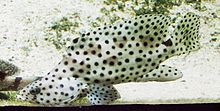Serranidae
| Serranidae Temporal range:
| |
|---|---|

| |
| Humpback grouper, Cromileptes altivelis | |
| Scientific classification | |
| Domain: | Eukaryota |
| Kingdom: | Animalia |
| Phylum: | Chordata |
| Class: | Actinopterygii |
| Order: | Perciformes |
| Superfamily: | Percoidea |
| Family: | Serranidae Swainson, 1839[1] |
| Subfamilies | |
|
see text | |
| Synonyms | |
|
Grammistidae Bleeker, 1857 | |
Serranidae is a large
Characteristics
Many serranid species are brightly colored, and many of the larger species are caught commercially for food. They are usually found over
All serranids are carnivorous. Although some species, especially in the Anthiadinae subfamily, only feed on zooplankton, the majority feed on fish and crustaceans. They are typically ambush predators, hiding in cover on the reef and darting out to grab passing prey. Their bright colours are most likely a form of disruptive camouflage, similar to the stripes of a tiger.[3]
Many species are
Like other fish, serranids harbour
Classification


In recent times[when?], this family has been proposed to be split. The two hypothetical families emerging from the remains of the possibly-obsolete taxon are the families Epinephilidae and Anthiadidae. This taxonomic separation is recognized by some authorities[who?], including the IUCN.[6]
Recent[
The subfamilies and genera are as follows:[8][9]
- Subfamily Anthiinae Poey, 1861[1]
- Gill, 1862
- Randall, 1990
- Anthias Bloch, 1792
- Baldwinella Anderson & Heemstra, 2012[10]
- Castelnau, 1872
- Caprodon Temminck & Schlegel, 1843
- Choranthias Anderson & Heemstra, 2012[10]
- Dactylanthias Bleeker, 1871
- Epinephelides Ogilby, 1899
- Giganthias Katayama, 1954
- Hemanthias Steindachner, 1875
- Holanthias Günther 1868
- Hypoplectrodes Gill, 1862
- Lepidoperca Regan, 1914
- Luzonichthys Herre, 1936
- Meganthias Randall & Heemstra, 2006
- J.L.B. Smith, 1954
- Odontanthias Bleeker, 1873
- OthosCastelnau, 1875
- Plectranthias Bleeker, 1873
- Pronotogrammus Gill, 1863
- Pseudanthias Bleeker, 1871
- Rabaulichthys Allen, 1984
- Sacura D.S. Jordan & Richardson, 1910
- Selenanthias Tanaka, 1918
- Serranocirrhitus Watanabe, 1949
- Tosana H.M. Smith & Pope, 1906
- Tosanoides Kamohara, 1953
- TrachypomaGünther, 1859
- Subfamily Epinephelinae Bleeker, 1874 (groupers)[1]
- NiphoniniD.S. Jordan, 1923
- Niphon Cuvier, 1828
- Tribe Epinephelini Bleeker, 1874
- Aethaloperca Fowler, 1904
- Alphestes Bloch & Schneider, 1801
- AnyperodonGünther, 1859
- Cephalopholis Bloch & Schneider, 1801
- ChromileptesSwainson, 1839
- Dermatolepis Gill, 1861
- Epinephelus Bloch, 1793
- GonioplectrusGill, 1862
- GracilaRandall, 1964
- Hyporthodus Gill, 1861
- Mycteroperca Gill, 1862
- Guichenot, 1868
- Plectropomus Pken, 1817
- SaloptiaJ.L.B. Smith, 1964
- , 1989
- Variola Swainson, 1839
- Tribe Diploprionini Bleeker, 1874
- AulacocephalusTemminck & Schlegel, 1843
- Belonoperca Fowler & B.A. Bean, 1930
- Diploprion Cuvier, 1828
- Tribe Liopropomini Poey, 1867
- Bathyanthias Günther, 1880
- Liopropoma Gill, 1861
- Rainfordia McCulloch, 1923
- Tribe Grammistini Bleeker, 1857
- Aporops Schultz, 1943
- GrammistesBloch & Schneider, 1801
- GrammistopsSchultz 1953
- Jeboehlkia Robins, 1967
- Pogonoperca Günther 1859
- Pseudogramma Bleeker, 1875
- Rypticus Cuvier, 1829
- Suttonia J.L.B. Smith, 1953
- Subfamily Serraninae Swainson, 1839[1]
- Bullisichthys Rivas, 1971
- Centropristis Cuvier, 1829
- Chelidoperca Boulenger, 1895
- CratinusSteindachner, 1878
- Diplectrum Holbrook, 1855
- Hypoplectrus Gill, 1861
- Paralabrax Girard, 1856
- Parasphyraenops T.H. Bean, 1912
- Schultzea Woods, 1958
- Serraniculus Ginsburg, 1952
- Serranus Cuvier, 1816
- incertae sedis
- ?†Blabe White, 1936 (Eocene, Egypt)
- Caesioscorpis Whitley, 1945
- Hemilutjanus Bleeker, 1876
- †Palaeoperca Micklich, 1978 (Eocene, Germany)
Notes
- ^ PMID 25543675.
- ^ Froese, Rainer; Pauly, Daniel (eds.) (2016). "Epinephelus lanceolatus" in FishBase. October 2016 version.
- ^ ISBN 0-12-547665-5.
- S2CID 12287737.
- PMID 21344838.
- ^ "IUCN red list taxonomies".
- PMID 25093850.
- ^ Eschmeyer, William N.; Fricke, Ron & van der Laan, Richard (eds.). "Genera in the family Serranidae". Catalog of Fishes. California Academy of Sciences. Retrieved 25 May 2020.
- ISBN 978-1-118-34233-6.
- ^ a b Anderson, W.D. Jr.; Heemstra, P.C. (2012). "Review of Atlantic and Eastern Pacific Anthiine Fishes (Teleostei: Perciformes: Serranidae), with Descriptions of Two New Genera". Transactions of the American Philosophical Society. 102 (2): 1–173.
References
- Froese, Rainer, and Daniel Pauly, eds. (2016). "Serranidae" in FishBase. October 2016 version.
- Sepkoski, Jack (2002). "A compendium of fossil marine animal genera". Bulletins of American Paleontology. 364: 560. Retrieved 2011-05-19.
